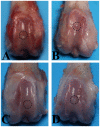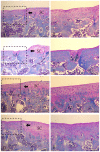Effect of treadmill exercise timing on repair of full-thickness defects of articular cartilage by bone-derived mesenchymal stem cells: an experimental investigation in rats
- PMID: 24595327
- PMCID: PMC3940955
- DOI: 10.1371/journal.pone.0090858
Effect of treadmill exercise timing on repair of full-thickness defects of articular cartilage by bone-derived mesenchymal stem cells: an experimental investigation in rats
Abstract
Objective: Current medical practice for the treatment of articular cartilage lesions remains a clinical challenge due to the limited self-repair ability of articular cartilage. Both experimental and clinical researches show that moderate exercise can improve articular cartilage repair process. However, optimal timing of moderate exercise is unclear. We aimed to evaluate the effect of timing of moderate treadmill exercise on repair of full-thickness defects of articular cartilage.
Design: Full-thickness cartilage defects were drilled in the patellar groove of bilateral femoral condyles in a total of 40 male SD rats before they were randomly assigned into four even groups. In sedentary control (SED) group, no exercise was given; in 2-week (2W), 4-week (4W) and 8-week groups, moderate treadmill exercise was initiated respectively two, four and eight weeks after operation. Half of the animals were sacrificed at week 10 after operation and half at week 14 after operation. Femoral condyles were harvested for gross observation and histochemical measurement by O'Driscoll scoring system. Collagen type II was detected by immunohistochemistry and mRNA expressions of aggrecan and collagen type II cartilage by RT-PCR.
Results: Both 10 and 14 weeks post-operation, the best results were observed in 4W group and the worst results appeared in 2W group. The histochemistry scores and the expressions of collagen type II and aggrecan were significantly higher in 4W group than that in other three groups (P<0.05).
Conclusions: Moderate exercise at a selected timing (approximately 4 weeks) after injury can significantly promote the healing of cartilage defects but may hamper the repair process if performed too early while delayed intervention by moderate exercise may reduce its benefits in repair of the defects.
Conflict of interest statement
Figures








References
-
- Simon TM, Jackson DW (2006) Articular cartilage: injury pathways and treatment options. Sports Med Arthrosc 14(3): 146–154. - PubMed
-
- Widuchowski W, Lukasik P, Kwiatkowski G, Faltus R, Szyluk K, et al. (2008) Isolated full thickness chondral injuries. Prevalance and outcome of treatment. A retrospective study of 5233 knee arthroscopies. Acta Chir Orthop Traumatol Cech 75(5): 382–386. - PubMed
-
- Kincaid SA, Van Sickle DC (1982) Effects of exercise on the histochemical changes of articular chondrocytes in adult dogs. Am J Vet Res 43(7): 1218–1226. - PubMed
-
- Zhuo Q, Yang W, Chen J, Wang Y (2012) Metabolic syndrome meets osteoarthritis. Nat Rev Rheumatol 8(12): 729–737. - PubMed
Publication types
MeSH terms
Substances
LinkOut - more resources
Full Text Sources
Other Literature Sources

